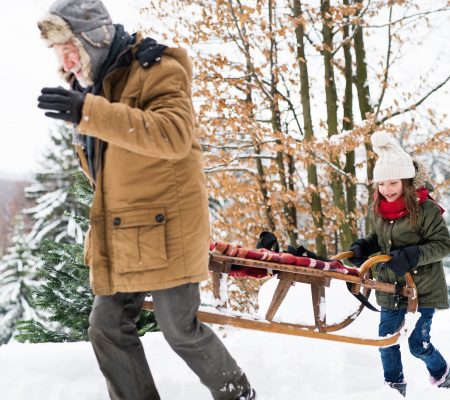Enjoy the Snow with These 7 Winter Injury Prevention Tips
Dr. Joseph Kroner, Blount Orthopaedic Associates
Despite the beauty of snow, winter weather can be uncomfortable and even dangerous. It’s tempting to hibernate until spring, but don’t despair. With a few smart winter injury prevention tips, you can still spend time (and yes, even enjoy yourself) outdoors.
After all, winter in Wisconsin is one of the most beautiful times of the year. The world is blanketed in white, fluffy snow and glistening icicles hang from the rooftops. People everywhere are getting on their snow gear and heading outside to hit the sledding hill or to build a snowman in their front yard.
It’s hard to believe despite all the beauty, the snow is still hazardous. Despite snow appearing soft and fluffy, injuries from snow activities are quite common. In the winter, we see an increase in  patients seeking orthopaedic care to treat injuries from snowboarding, skiing, sledding, and simply slipping during snow removal.
patients seeking orthopaedic care to treat injuries from snowboarding, skiing, sledding, and simply slipping during snow removal.
Fortunately, whether you enjoy snow sports or are just stuck cleaning it up, Dr. Joseph Kroner from the Orthopaedic Hospital of Wisconsin has some great winter injury prevention advice to keep you healthy and safe.
7 Winter Injury Prevention Tips to Keep You Safe in the Snow
Winter sports injuries are quite common and usually include sprains, strains, fractures, and dislocations. It’s important to remember that ultimately snow is frozen water, a.k.a. ice, and as we all know, ice is hard, slippery, and dangerous.
But winter sports are also exhilarating and fun. There are many benefits, both mental and physical, from spending time outdoors. Getting some sun on the slopes, the sledding hill, or the ice is part of the reason people love the winter. Sports, including hockey and curling, are popular for a good reason—during the doldrums of winter, these activities make us feel social, healthy, and happy.
So don’t call off winter sports altogether. Instead, Dr. Kroner recommends the following 7 tips for winter injury prevention, no matter the outdoor activity.
1. Warm-Up Before Your Activity
The simple act of warming up by stretching and moving before your winter activity will prepare your body for movement. Warming up is good practice before any activity, but it’s especially important in cold weather. Stretching before exerting yourself will prime your muscles and tendons for action, making you less likely to get injured.
2. Take Regular Breaks During Winter Activities
Skiers and snowboarders know that movement in the cold can be extremely taxing on your body. After a day on the ski hill, it’s not uncommon to feel completely exhausted. If you want to prevent winter injuries, stay cognizant of your energy levels and know when it’s time to take a break or stop for the day. Exhaustion and overexertion are common reasons why patients sustain injuries.
3. Stick Together in the Winter
The most significant danger in winter weather is often the cold. When temperatures get frigid, even a minor injury can become dire. Keep a friend or family member with you whenever you go out in the winter weather. If you’re cross-country skiing, snowshoeing, or skating, it’s better with a buddy. At the very least, tell someone exactly where you plan to go and an ETA for your return; this is a good safety practice in general, but especially in cold weather.
4. Protect Yourself with the Right Equipment
Winter gear is an investment, for sure, but it’s an essential method of protection. Many injuries happen because the gear is old, worn out, or doesn’t fit properly. When you’re going up against nature, you’ll want the right clothes and tackle. Check your equipment before heading out and wear appropriate gear for the activity, whether that means gloves, helmets, knee pads, or other protective apparel.
5. Wear Layers to Protect Yourself from Cold
Layering is always a good idea when it’s cold outside (even if you’re walking the dog around the block or taking out the trash). It’s much easier to remove a layer than it is to get warm again once you’re cold. Remember, your feet are the key to keeping your body comfortable and protected. Warm, dry boots will make any winter experience safer and more enjoyable.
6. Stay Hydrated and Healthy
With snow and ice everywhere, it’s easy to forget to drink up! Skiers, snowboarders, and hockey players often forget how dehydrating winter activities can become. When you’re having fun in the snow, don’t dismiss the importance of drinking water (especially if your water freezes up). Carry an insulated water bottle with you and always check the weather report before going out.
7. No Matter the Winter Activity, Use Proper Form
No matter the activity, whether it’s walking, hiking, snowshoeing, or hitting the ice, it’s important to follow the guidelines for proper form. Listen to your coach or instructor, and know your limits. This even includes one of the most common sources of winter injury: shoveling snow.
Preventing Common Snow-Shoveling Injuries
While we might not think of snow removal as a “fun winter activity,” it’s still a significant cause of winter injury. In fact, Dr. Kroner reports it’s one of the more common causes of winter injuries we treat.
According to the American Journal of Emergency Medicine, there are over 11,000 snow shoveling related injuries each year. And according to the U.S. Consumer Product Safety Commission, snowblower-related injuries are also widespread and hazardous, including back and shoulder injuries, finger lacerations, and even amputations.
When you go out to shovel the walk, you should think of the same “gear up” tips you’d use for preventing injury during any (fun) winter activity. We might not think of this winter chore as something that requires preparation, but the truth is, shoveling snow is a highly exhausting and exerting activity. Dress in layers, stay hydrated, stretch before you start, and take breaks. Wear boots with excellent traction before you go out on icy walks.
The best approach to snow shoveling is to push the snow rather than lift. Work in shifts and opt for several small shoveling sessions, rather than letting the accumulation pile up. If you need to lift a shovel-full of the white stuff, you should squat, lifting with your legs. Never lift snow with your arms, shoulders, and back. If you’re lucky enough to have a snow-thrower, follow the guidelines provided in your snowblower manual—turn the machine completely off before clearing clogs, wear eye protection, and never reach into a moving snowblower (think of it as similar to lawnmower safety).
By following these winter injury prevention tips and guidelines, you’ll hopefully avoid most types of common winter injuries. However, should you sustain an injury, the experts at Orthopaedic Hospital of Wisconsin are here to get you back on the ice, the slopes, or just your driveway.


